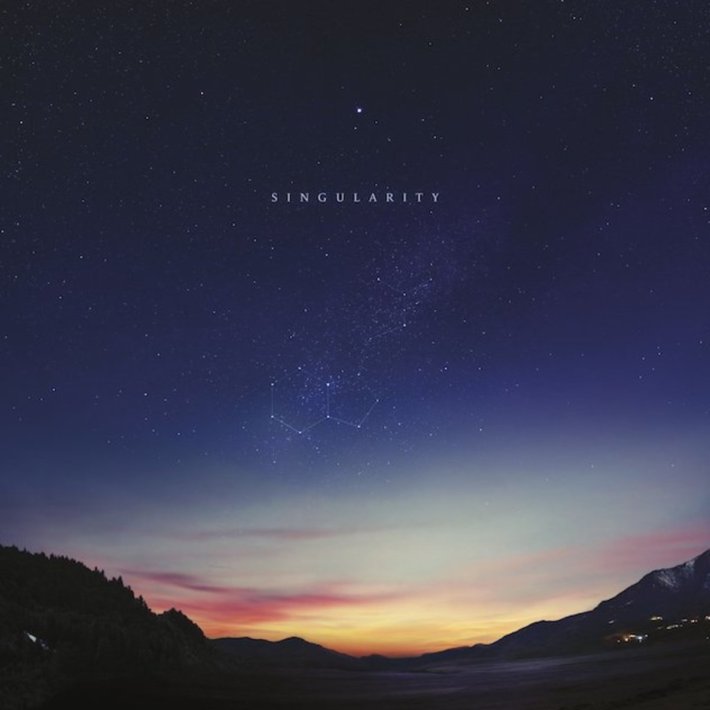Over the summer, I found myself at Hammerstein Ballroom surrounded by more than 2,000 ecstatic Vocaloid fans, each equipped with a color-changing wand (something between a lightsaber and those conical lights that ground control uses to direct runway traffic at airports). Without much warning, the crowd would sync up their movements in spontaneous choreography along with the music, which ranged in style from disco to rock to pop, and was played by a live band. But the band was fronted by a rotating cast of anime avatars in 10-foot-tall hologram form, each representing a different pitch of vocal-tuning software that literally anyone can purchase and create songs with.
The setlist featured each character's most popular user-generated anthems, all undoubtedly electronic in origin, with no nods to the anonymous fans who originally composed them. This Bandcamp article goes into a little more detail about the diversity within the Vocaloid community; until I read it, I'd assumed the stuff my pre-teen niece had been listening to was just a Japanese version of Josie And The Pussycats, rather than a musical blank slate in the form of software that can be used to disseminate original content to a ready-made audience. It must be rather freeing to create behind the veil of a marketable persona without having to build a brand for yourself.
I don't know if this is the natural endgame for electronic music, which has brandished the concept of the "mysterious producer" since its inception, obscurity the ultimate badge of honor. A scant biography can work to a person's advantage, particularly if they're in the early stages of working out an approach. But that model isn't applicable to rock bands and pop stars; guitar solos can't be programmed and vocal hooks don't sing themselves. Software and hardware alike need a human behind them too, but they obscure their source in the process. It's natural to want to know who or what is making the sounds we consume, but only in electronic music can we accept that this information is an afterthought. It's all mythology.
In a genre that can include lush ambient arrangements, sweaty club jams, larger-than-life festival dub, harsh noise, sound collage, or any permutation of the above, the truth is that roadmaps are only semi-useful. Identities can be as nebulous as beats, and that holds a special kind of power when it comes to breaking down industry roadblocks that dictate commercial viability along gender and racial lines. As such, the way that a producer or DJ evolves can become a compelling backdrop for what they create, but it's always in service of some type of uniting rhythm that ultimately lets its audience decide how to interact with it. Electronic music's biggest danger is falling into faceless cliché, but the artists on this list manage to avoid that by venturing into unexpected territory, and in 2018, that any territory has been left unexplored is no small wonder. As other genres crib from electronic production and incorporate it into the mainstream, there will always be a fresh batch of innovators pushing music culture forward. This year, here's what that looks like.

10 Shinichi Atobe - Heat (DDS)
There's a timeless quality, a purity, an emptiness even, about Shinichi Atobe's latest release, Heat. The very definition of an enigmatic producer, little is known about him. A 2001 EP titled Ship-Scope earned him a cult following -- and then, radio silence. Resurrected by Manchester crate-diggers Demdike Stare (whose thunderous Passion LP arrived in October), a steady stream of Atobe's work has appeared via airmail at the offices of Demdike's DDS imprint since 2014.
Heat is among the most satisfying of these, tapping into the most elemental aspects of house music. It's a soothing essentialism that could only be rendered by a master, engrossing in its simplicity and attention to rhythm. With Heat, Atobe's given us a collection of meditative beats peppered with occasional piano, but mostly just hovering, like air diffraction on a wiggling horizon.
Featuring seven tracks that are all more than eight minutes long (and one frisky piano ditty entitled "Bonus" that clocks in at three), Heat often feels as though it could spool out forever in an effortless, noncommittal drift. Oddly, they're pretty distinct from one another -- despite the fact that there are four each named "Heat," numbered but presented out of order. The spongey warp of "Heat 2" could never be mistaken for what sounds like oscillating Baoding balls clacking against one another on "Heat 4," and that speaks to the depths of expression still possible within minimalistic house. If Atobe were to make a more well-known name for himself heading up high-profile production projects -- which doesn't seem like much of a leap, and, for all we know, could be a reality already -- he could build these tracks up to towering heights. Left as they are, they're islands unto themselves, best summed up in the title a pair of them share: "So Good, So Right."
HEAR IT: Spotify | Apple Music

9 Amnesia Scanner - Another Life (Pan)
In a now-ubiquitous cartoon, a doofy-looking dog takes his coffee in a room engulfed by flames. "This is fine," reads the speech bubble above his fedora, and you're not sure if he's bitingly sarcastic or grasping for reassurance. Berlin-by-way-of-Helsinki duo Amnesia Scanner make the musical equivalent of the K.C. Green-penned strip -- it's a soundtrack for shrugging in the face of deep discontent. Ville Haimala and Martti Kalliala began collaborating almost a decade ago, producing crowd-pleasing club cuts under the name Renaissance Man. But as alarmist end-of-the-world scenarios flickered closer and closer to reality, a jaded sort of horror discolored their aesthetic; they scrambled their former moniker to spell out Amnesia Scanner and haven't looked back on those dim memories since.
Listening to their debut full-length Another Life isn't unlike binge watching Black Mirror. The pop structures are there for palliative entertainment value, but they only register on a cerebral level, distorted as they are by layers of grating digital detritus. Through the poisonous fog comes two plangent voices. First, there's experimental composer Pan Daijing, on the desperately wretched "AS Unlinear" and "AS Chaos," which functions as a late-album thesis statement, a chilling mantra of "All around you, it's just chaos."
But more disconcerting than Daijing's despondent wail is another presence, this one entirely digital. Known as Oracle, it stretches from a syrupy slur to a robotic falsetto around the nightmare-fuel music box melody of "AS A.W.O.L." It hints at the promise of some parallel universe on the buzzing title track. It mimics a searing mizmar bleat on "AS Symmetribal." And its asyllabic groans and screams bluster throughout "AS Faceless" as though tormented by its own lack of flesh. It's not uncommon for electronic music to enumerate the ills of technology run amok, but Amnesia Scanner stand out as being among the most acerbic. Ironically, it's the remove with which they observe the downfall of our sick, sad world that makes Another Life especially jarring, as if to say: We're all just bug-eyed animals in a room on fire.
HEAR IT: Spotify | Apple Music | Bandcamp

8 RRUCCULLA - SHuSH (BIIPBIIP)
I wasn't sure Google translate was accurate, so I checked with a Spanish-fluent friend: Someone has indeed written a song called "Eyelid Dress." That someone is 24-year-old Spanish drummer/producer Izaskun González, who has a few different Bandcamp monikers. The one that seems to be working out best for her is RRUCCULLA, and her latest album Shush is such an absorbing, kitschy, and joyful effort that it made a very late addition to this list in a calendar year jam packed with many deserving releases.
Surreal idioms make telling song titles for this peculiar batch of tracks, which sound as though they've been created by an over-caffeinated Foley artist at a rave. It's not that she has recorded sounds so much as shapes, imbued with a childlike sense of humor, play, and abstraction. Chew toy squeak, kettle hiss, carbonation, letting the air out of a balloon -- these are incorporated into a sort of free jazz backdrop, the occasional vocals pitch-shifted beyond all recognition of humanity. These found object noises and the ebullient filters they've been processed through make Shush a supremely tactile listen. It's musique concrète for the era of sensory overload.
When González scales back the onslaught, as she does on "Icy Blue Coral" or "Menta Fútil," her work veers into the hyperrealism of Pilar Zeta and Oneohtrix Point Never (both of whom also put out excellent records this year). "Balada Cítrica" summons a vision of sprigs of alien fauna shooting into rarefied air before the harsh transition into the high-strung, spacey "Tea Gambler" obliterates them. Bleating horns, plunking piano, and live drumming pop up throughout the LP, moving through a bulbous, plasticky architecture that makes the overall product hard to pin down. But Shush is nothing if not a riddle, wholly original and way out in left field. Even by the album's final track, "Cicatriz de Chocolate," you wouldn't necessarily anticipate the breakbeats and brass skronk that slice through placid, previously established tinkling tones -- only that, true to translation, a "Chocolate Scar" would leave an impression, like a foreign object pressed into silly putty.
HEAR IT: Spotify | Apple Music | Bandcamp

7 Skee Mask - Compro (Ilian Tape)
There is no denying the importance of a throbbing breakbeat when it comes to drum and bass, but Compro, the latest full-length from Munich producer Bryan Müller (AKA Skee Mask) proves that there can be so much more to the subgenre than its unflagging pulse. The very definition of a wunderkind, Müller started playing drums at age nine. (Surprisingly,Compro is not the only record Müller put out this year: Only two weeks before its release he dropped the more straightforward Scenes And Sketches From The Lab under his SCNTST moniker.) He still relies heavily on his vibrant sense of rhythm, but lush synth pads provide both connective ambient tendons and a buffered landing for every percussive articulation.
That's not to say that Compro dispenses with melody altogether -- the trilling piano glissandos on "Flyby Vfr" spring to mind -- it's just that he uses it to dial up the bathos of compositions so intricate they might otherwise feel impenetrable. For instance, "Cerroverb" kicks things off with an icy nonchalance, but halfway through the track a disembodied lung takes a gulp of air, reversed samples swelling beneath its glacial haze. The restraint Müller shows here has a big payoff over the next few tracks. A crunchy build on "Session Add" takes a full four minutes to dissolve into its scintillated groove. An alien assonance caps off the chill of "Rev8617." But then the whole thing collapses into the electroclash-esque crush of "50 Euro To Break Boost," an ode, no doubt, to his Boys Noize-indebted breakout. Still, it's not an onslaught; a resonant chord echoes in an out of the beat as though from someplace beyond it.
"Via Sub Mids" and "Soundboy Ext." keep up the pace, while the dissonant bells and a saw-toothed synth zap rescue "Dial 247" from any hint of monotony. Ambient atmospherics on tracks like "Vli" or album closer "Calimance" are never Skee Mask's focus, but they temper the breakneck tempos, and heighten the energy of Compro simply by comparison. Producers of Müller's ilk might take a lifetime to achieve such capable balance and immaculate detail, but even the simple fact that he thought to try is astonishing evidence of promising new talent.
HEAR IT: Spotify | Apple Music | Bandcamp

6 Tim Hecker - Konoyo (Kranky)
Early in his career, Tim Hecker made ambient music so unmoored from a sense of place that he went so far as to name his 2009 LP An Imaginary Country. From that point on, he began working with a series of collaborators that helped him establish boundaries, borders, and broader sonic palettes. The last of these associates, for the choral arrangements that formed the aery strata of 2016's Love Streams, was Icelandic composer Jóhann Jóhannsson, whose disquieting drones have scored the films of Denis Villeneuve, Darren Aronofsky, and this year's preposterous, malevolent Mandy. Jóhannsson died unexpectedly in February of an accidental drug overdose, but not before suggesting that Hecker begin to explore negative space as an antidote to his characteristically dense work, offering up Japanese court music known as gagaku as an inroad.
Konoyo is not expressly a tribute to Jóhannsson. But gagaku performances are often reserved for Shinto religious ceremonies, including honoring ancestral spirits; ruminations on the liminal spaces between life and death resonate within the semitones of the pentatonic yo scale that inform gagaku's basic execution. Hecker and the Tokyo Gakuso ensemble, led by Motonori Miura, leaned on improvisation rather than classical gagaku, finding common ground in abstract concepts despite the literal incompatibility between Hecker's digital set-up and the pitch of ancient Japanese woodwinds.
"Is A Rose Petal Of The Dying Crimson Light" embodies the ephemeral beauty of that very thing in its yawning, distant strings, its breathy, hollowed-out flute, and its spacious, globular synths. The placid surface of "In Mother Earth Phase" cycles through deep and rumbling tectonic shifts as it stretches across 10 minutes, the force feeling both destructive and regenerative. Despite the disparate sonic origins between Hecker's output and that of gagaku, nothing makes the connection more ironclad than the appearance of a 17-piped mouth organ called a shō in Konoyo's opening track, "This Life." Its eerie drone is so akin to the sounds Hecker has gravitated toward over the past two decades of his career, particularly his more recent work, that it's a wonder he hadn't found it sooner. You can almost imagine Jóhannsson's misty specter nodding gleefully over the proceedings.
HEAR IT: Spotify | Apple Music | Bandcamp

5 Helena Hauff - Qualm (Ninja Tune)
Even in a genre that readily embraces the future, it is still possible to find a Luddite. German producer Helena Hauff certainly fits the bill, forgoing any kind of social media presence, DJing vinyl-only sets across the world, and strictly insisting on the use of analog synths and drum machines to create her rough-hewn, stripped-down, retro-futuristic acid house. Hauff isn't the only musician to fetishize the Roland Juno despite the accessibility that more modern technology offers, but her anachronistic approach creates a unique dialogue between herself and her machines. Just as she learned to read the room (and then obliterate it) during her DJ residency at Hamburg's infamous Golden Pudel nightclub, her sophomore effort Qualm is at its best when Hauff intuitively lets the idiosyncrasies of her vintage hardware take the wheel.
As a punk who found a home in gritty electro, Hauff's love of darkwave, industrial, and post-punk informs her solo work, superimposing a staticky kineticism over the kind of dystopian haze that might soundtrack '80s sci-fi films. "Primordial Sludge" and "Hyper-Intelligent Genetically Enriched Cyborg" build drama layer by squelchy layer, while "Lifestyle Guru," "The Smell of Suds and Steel," and "Barrow Boot Boys" thud and fizzle, their churning beats coarsened just enough to reflect Hauff's affinity for both disorder and dynamic repetition. Though they feel less grimy and muscular, the album's most accessible tracks -- the urgent gyre of "No Qualms," the squalor and stomp of "It Was All Fields Around Here When I Was A Kid" -- seam up the record's more wistful desires. Hauff's vintage version of the future is absorbing because it strives to inhabit physical space in the here and now, arriving recklessly to a libertine apocalypse.
HEAR IT: Spotify | Apple Music | Bandcamp

4 DJ Koze - Knock Knock (Pampa)
Often noted for his eccentric persona, Stefan Kozalla has been called a genius, a maverick, and a master turntablist; some three decades into his career he's come into his own as a DJ Koze, curator of sound. Whether incorporating his beloved extended cut of Låpsley's "Operator" into a live set or heading up unconventional house label Pampa Records, Koze prides himself on breaking from worn-out techno tropes, eschewing generic, plastic beats in favor of organic, golden textures. His ability to discern between the two manifests brilliantly on Knock Knock -- his first album of solo work since 2013's Amygdala -- wherein he collages house, disco, pop and indie with his own lush loops and a smattering of smartly appointed guest vocalists like Róisín Murphy, Sophia Kennedy, José González, Kurt Wagner of Lambchop, and Speech of Arrested Development.
To keep the vocals disparate from their backing tracks, he rewrote the instrumentals he'd originally sent to his collaborators, changing the songs entirely. That bait-and-switch typifies Koze's mischievous streak, and often results in some unforgettable juxtapositions: Murphy's breathy undulations cruise over the galloping "Illumination," Kennedy's stern German curdles against the dream-pop ambience of album closer "Drone Me Up, Flashy."
Descended from hip-hop lineage -- as a teenager, he was a founding member of the hugely popular Hamburg-based hip-hop trio Fischmob -- Koze also knows his way around a sample, using Bon Iver's "Calgary" to give "Bonfire" the oxygen to burn, or a snippet of Gladys Knight to lend a mournful quality to the otherwise buoyant stand-out "Pick Up." Koze makes it look easy, but he labored over the record for five years, whittling the tracklist from 28 songs into an ecstatic glut of 16 by listening to them in different states of mind -- waking, drifting to sleep, high, drunk, hungover.
What remains is a collection that you'd have to be braindead not to enjoy, imbued with nostalgic undertones but mostly avoiding cliché, as clever as anything the Avalanches or the Books ever put to tape. Though he stressed over his choices, he almost always makes the right ones -- whether it's the intrusion of a digital yelp cutting through glimmering strings during the LP's opening moments, the wistful glint of "Music in My Teeth," the cartoonish twang and handclaps of "Planet Hase," the squelch of Auto-Tuned vocal over the dirty thrum of "Jesus." Every song slaps, and yet Knock Knock functions best as an extended mix -- no small feat in the age of the streamable playlist. To tune into any one moment wouldn't give an accurate picture of the whole. DJ Koze taps into this magic by flouting convention and doggedly pursuing less-traveled routes. As a result, Knock Knock feels celebratory at every turn, reveling in the joy of rebellion.
HEAR IT: Spotify | Apple Music

3 Yves Tumor - Safe In the Hands Of Love (Warp)
There's something to be said for the artist that can stare into the abyss and not only see the beauty there, but is also able to translate its unknowable qualities via their work. On Safe In The Hands Of Love, Yves Tumor peels back deceptively comforting layers -- both sonic and emotional -- to find divinity in the grotesque. He goes about this delicate business with an arsenal of vibrant samples, staticky ambient interludes, plaintive vocal textures, even seething guitar. Shot through with R&B, noise, alt-rock, and ambient flourishes, Tumor's production work has never been more compelling. Now, it has evolved from the meandering grooves of his previous records into a platform for Tumor's weighty meditations on politics, love, and the false sense of security either might give or take away.
The album's centerpiece and lead single "Noid" is a treatise on police brutality swaddled in soaring string samples (from "Grace" by Sylvia St. James), but the whole record evokes the kind of quaking anxiety that permeates marginalized communities in Trump's America. No matter how tangible the threat from the outside, Tumor often saves his rawest evaluations for his own addled psyche, even finding a kind of freedom in doing so. By the album's cauterizing final track, you can barely hear him wailing over the cymbal crashes, droning orchestration, and serrated guitar, but he's making a promise: "I can be the one to give you peace of mind."
He's clearly not one to placate, though, instead seeking a tenuous compromise between foreboding and hope, a place where both can exist side by side, a recognition that safety and love are illusory. He excavates his own traumas as though digging through record crates, and ultimately finds catharsis in cobbling those two obsessions together.
HEAR IT: Spotify | Apple Music

2 Jon Hopkins - Singularity (Domino)
It's hard to imagine a more focused producer-composer than Jon Hopkins, the Coldplay and Brian Eno collaborator who truly hit his stride with 2013's Immunity. His exacting work smartly melds together hundreds of individual tracks with relatively minimalist results, hinging on the interplay between primal house beats and cinematic ambient underpinnings. Singularity takes this to extremes: It could practically be parted into two stand-alone works, one ambient, one dance music. But as its title suggests, the folding together of these genres makes the whole greater.
As ever, both elements are informed by Hopkins' training as a classical pianist, his work as a DJ and film scorer, and an innate curiosity that extends beyond music into matters of the metaphysical. Hopkins hones these trademark traits to a finite point, the crystalline clarity of his approach suggesting that his forays into Transcendental Meditation, autogenic training, ice baths, regulated breathing, and other paths to enlightenment have proven at least partly successful when it comes to creative inspiration.
But Hopkins is no cultist; even when his song titles seemingly reflect his esoteric leanings, they also serve as cheeky double entendres. And so, a track like "Luminous Beings" could just as easily describe bodies glistening in the neon and heat of a crowded club or alien lifeforms from some distant planet, its twitchy throb anchoring celestial piano and synth. The title track might be a boastful nod to his own prodigious talent, or might describe its gravitational pull, like that of a black hole, sucking up Hopkins' long-standing acid house influences, mood-building prowess, and Reichian penchant for slightly askew repetition.
Hopkins has an uncanny flair for minuscule shifts in texture that easily quell any threat of monotony. A buzzy pulse signals a skittering breakdown on "Singularity"; a sudden stutter propels "Emerald Rush" as a disembodied and ethereal voice uplifts it; the churn of "Everything Connected" becomes subtly muddled, as though heard through a thin membrane or from another room; the distorted keys of "C O S M" plunk like raindrops forming in an airy cloud, eventually building to a gentle turbulence. Even as Hopkins attempted to access some spiritual plane by pushing his physical body to its limits, he never forgot that the corporeal sensations of music like this remain the swiftest way to arrive there.
HEAR IT: Spotify | Apple Music | Bandcamp

1 SOPHIE - OIL OF EVERY PEARL'S UN-INSIDES (Transgressive/Future Classic)
Though SOPHIE had already made an eponymous name for herself via high-profile collaborations with Madonna, Charli XCX, Cashmere Cat, and Vince Staples (among others) and a 2015 release compiling her enigmatic early singles, OIL OF EVERY PEARL'S UN-INSIDES is as triumphant a studio debut as they come. The album's title and cover art conjure Sandro Botticelli's Birth Of Venus -- a goddess emerging, fully-formed in an amorphous aquascape, fire-red curls and all -- but neither SOPHIE's persona nor her work are concerned with tropes from antiquity. Rather, as SOPHIE forges and relishes in her own myth, she embraces and critiques the hyper-realistic future of pop music.
Creating every sound on the record (other than vocals) from scratch, SOPHIE's attention to elastic, otherworldly details make her a singular producer and put her work on par with high-gloss sculpture, though it only rarely eschews the spirit of grinding it out on a sweaty dancefloor. One tender moment -- glittering album opener and lead single "It's Okay To Cry" -- establishes the album's radical vulnerability from its outset. Premiering as a self-directed video, it marked the first time that SOPHIE had used both her own voice and image as a centerpiece, thus lifting the veil of the previously shrouded producer, who had recently come out as trans.
"Is It Cold In The Water?" and "Infatuation" are similarly sweeping and revelatory in nature, but SOPHIE doesn't stop at only one expression of the sublime -- the jittery, mechanical bomp of club bangers like "Ponyboy" and "Faceshopping" represent the hedonistic side of the same coin, and in the space between these two poles SOPHIE provides both a context for her own improbable existence and the space for listeners to come along for the ride. As though outlining that very plan, the album's closing track (and also its working title) "Whole New World" promises a veritable revolution, one in which newly dissolved social borders create a means to turn pop inside out.
HEAR IT: Spotify | Apple Music






